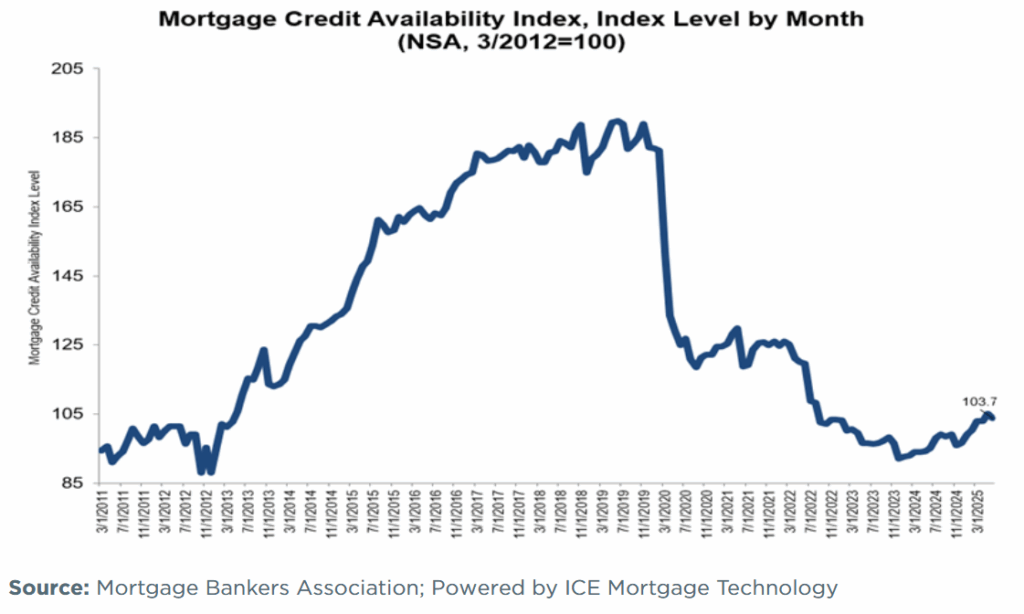According to the latest Mortgage Credit Availability Index (MCAI) from the Mortgage Bankers Association (MBA), mortgage credit availability decreased in June, dropping by 1.3% to 103.7. A decline in the MCAI indicates that lending standards are tightening, while increases in the Index are indicative of loosening credit. The MCAI was benchmarked to 100 in March 2012.
The MBA reports that in June, the Conventional MCAI decreased 1.2%, while the Government MCAI decreased by 1.7%. Of the component indices of the Conventional MCAI, the Jumbo MCAI decreased by 0.7%, and the Conforming MCAI fell by 2.2 percent.
“Credit availability decreased in June after six months of growth, primarily led by fewer programs with low minimum credit scores,” said Joel Kan, MBA’s VP and Deputy Chief Economist. “There was also a reduction in streamline refinance programs. With the job market softening, and increasing mortgage delinquency rates, some lenders are tightening up their credit offerings. Jumbo credit availability decreased slightly overall relative to the previous month, but the availability of non-agency loan programs increased slightly.”

Churning Economic Forces
According to the Bureau of Labor Statistics (BLS), job growth proved better than expected in June, led by government hiring. Nonfarm payrolls increased a seasonally adjusted 147,000 for the month, higher than the estimated 110,000 and just above the upwardly revised 144,000 in May.
The BLS also found that the unemployment rate fell to 4.1%, the lowest since February 2025, and against a forecast for a slight increase to 4.3%. Though the jobless rates fell, it was due largely to a decrease in those working or looking for jobs. In June, labor force participation rate dropped to 62.3%, its lowest level since late 2022. The household survey, which the BLS uses to calculate the unemployment rate, showed a smaller employment gain of just 93,000, as those who had not looked for a job in the past four weeks rose by 234,000 to 1.8 million.
Experian found that, in line with the MBA’s MCAI data, first mortgage delinquencies and foreclosures increased in June 2025, particularly in later stages of delinquency. Home equity delinquencies remained low, signaling stability in that segment. Mortgage originations were up, with refis beginning to recover. HELOC direct mail offers have surpassed first mortgage offers, driven by aggressive marketing and AVM-based personalization.
Delinquency and foreclosure metrics indicate an upward shift in credit risk, particularly in first mortgage portfolios. Data trends show that early-stage delinquencies—30 Days Past Due (DPD)—are steadily increasing, according to Experian’s analysis. More concerning is the continued progression of loans from 90 DPD to 120 DPD and ultimately into foreclosure, suggesting that borrower distress is not isolated but escalating through the default pipeline. This sustained deterioration in performance warrants enhanced
vigilance from servicers and risk managers. Integrated portfolio monitoring, credit-based scoring overlays, and property data models offer a more proactive approach to identifying and mitigating risk.
In contrast, home equity products, especially HELOCs, have shown some resilience. Both early- and late-stage HELOC delinquencies have declined or stabilized in recent months. This contrast may reflect the different borrower profiles or underlying risk exposure between first mortgage and home equity borrowers.
The post Lenders Clamp Down on Credit Offerings Amid Market Uncertainty first appeared on The MortgagePoint.























